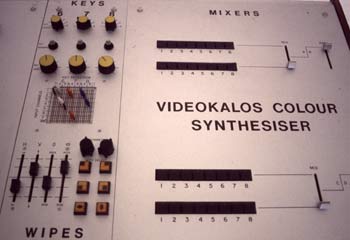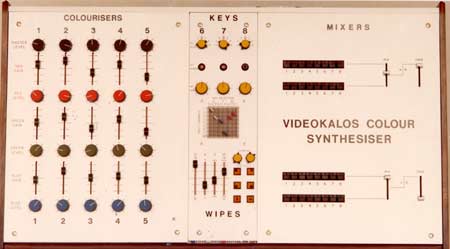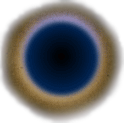
ALTHOUGH THE Videokalos Colour Synthesiser may not offer a specifically new technology – like the digital effects processors eagerly awaited by PAL broadcasters – it’s novel conception seems to offer intriguing flexibility for synthesising and manipulating colour images, and for other kinds of effect.
The synthesiser can manipulate five inputs independently – colorizing monochrome sources or varying the level and gain of the colour components (RGB) of colour sources. Together with the synthesiser’s other features – three further inputs to a wipe generator and keying panel, and a four-bank (ABCD) eight-input switcher – the whole unit can be used either as the main mixer in a small studio, as a sophisticated postproduction mixer in editing, or as a special effects unit for broadcast studios. (The device has its own built-in sync pulse generator, switchable to PAL or NTSC, but can equally well be locked to a broadcast studio’s generator.)
The synthesiser represents an essential rethinking of the design and layout of control equipment, incorporates a range of functions normally handled by separate pieces of equipment, and it brings before one operator a range of controls that would in most existing broadcasting studios be spread out between different operators and locations. Some effects are usually at the disposal of the vision mixer – and sometimes the electronic effects operator – but any such complex variations of colour balance are normally handled separately in the vision control room, physically separate from director and vision mixer, before the source is presented to the vision mixer.
The synthesiser is claimed to be “the first true video ‘mixer’ in the sense that we have come to use the term when referring to audio mixers”. According to the synthesiser’s designers, most existing TV mixer units “do not allow one to control and modify the parameters of the electrical signals of the selected sources has become common practice with audio.” The synthesiser’s affinity with a musical instrument or electronic music synthesiser are not surprising, given the equipment’s origins.
It was designed by Peter Donebauer and Richard Monkhouse – Donebauer works as a visiting lecturer in Experimental Video at the London College of Printing, where one of the first synthesisers is installed. He is an established video performance artist and needed a device that gave him precise control in manipulating images, but in an extremely portable form – the synthesiser is a self-contained panel 6″ x 22″ x 41″ and can be supplied with a flight-case. Monkhouse has designed a number of audio synthesisers.
The synthesiser’s eight channels are mixed in the switcher section at the right of the panel. Most mixing is done on the AB banks. The twin outputs of the CD banks can be used for preview, special effects processing external to the machine or for re-entry to the AB banks – although the facilities elsewhere on the panel should make this option normally superfluous.
A single picture source can be fed to two or more of the five colouriser inputs simultaneously, so several different manipulations of the image – colourising a monochrome source or rebalancing RGB on a colour source – can be accomplished simultaneously and independently. The operator can then cut or mix between them on the switcher.
The synthesiser’s other three channels (6-8), each with its own independent key, provide an extremely versatile range of special effects, together with a wipe generator permitting horizontal, vertical and corner wipes and a variable wipe consisting of two ellipses. (The interference area between the two variable ellipses gives the wipe waveform such as circle, cross or “flying saucer”.)
A 22 x 22 hole patchboard is used in conjunction with the three keys. Each key may select as its triggering source any of the five monochrome inputs to the colouriser, any of the 15 RGB colouriser outputs, the other key channel outputs, the wipe generator or an independent external key output. It may also select any combination of RGB outputs of the colourising section, which, by varying the balance of the three colours at this point allows full chroma-key off any colour of an original scene. Three independent chroma-keys are thus possible. The operator may also key off a combination of channels, equivalent to keying off a mix of two to seven channels simultaneously.
Any combination of colours, from any source in the synthesiser (including the other key inputs) may be placed on each side of the key. By using the patchboard the three key channels may be ganged sequentially and set for different key levels. This provides up to four levels of colourisation of a single image, with full analogue video information within each level rather than the block colour effect usually seen in quantising effects. Moreover, as positive/negative colour mixtures are possible within each level a very complex colouring potential can be achieved.
It is difficult to gauge what response the equipment will find from TV engineers who normally purchase and install studio facilities, nor its impact upon traditional job demarcations. But clearly the versatility of effects that are possible – and possible under more creative control than previously available – should excite television producers, particularly those interested in exploiting the potential of the studio, and those working on music programmes. And, indeed, several producers have already trekked to the Brixton cottage industry, and are interested in hiring the synthesiser for specific programmes.
Technical notes: The AB banks produce an encoded signal switchable to PAL or NTSC – alternatively RGB can be fed to an external encoder for SECAM – and one of the first synthesisers was shipped to Paris. The synthesiser also incorporates a colour bar generator and provides outputs of oscilloscope drive waveforms.
The Videokalos Colour Synthesiser – on the left the five colouriser inputs with separate controls for RGB level and gain on each input; in the middle three further inputs with keying and wipe controls; and on the right the 8-input ABCD mixer panel.

